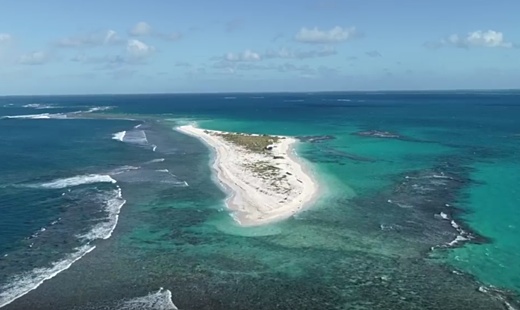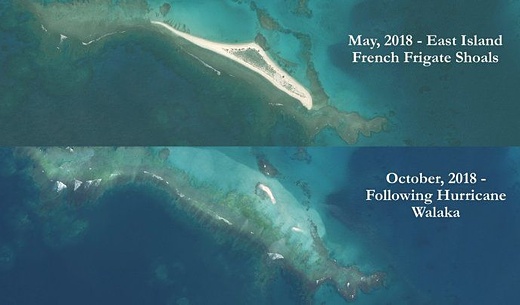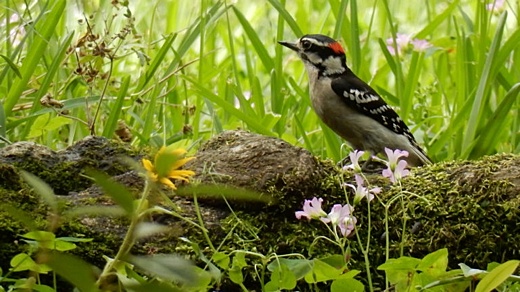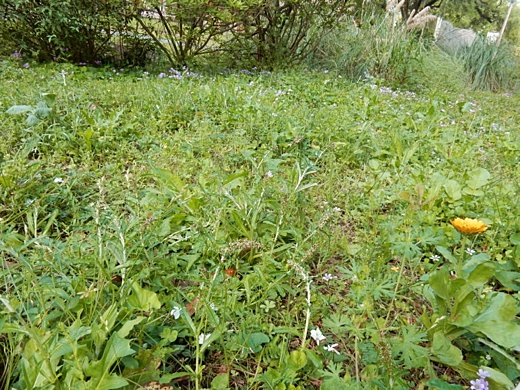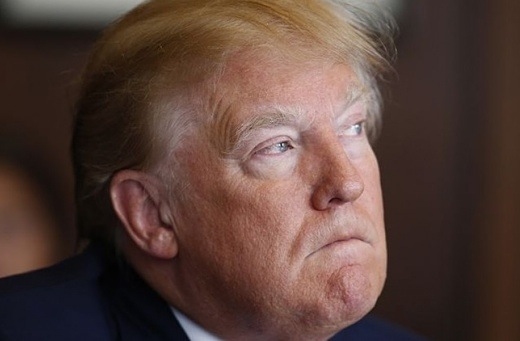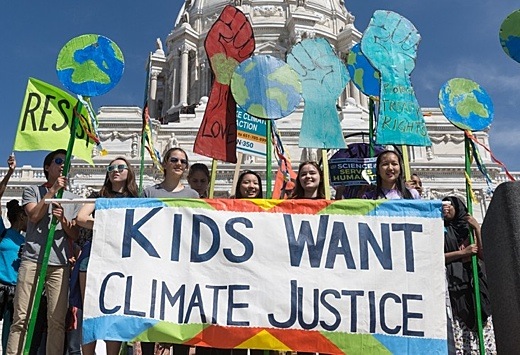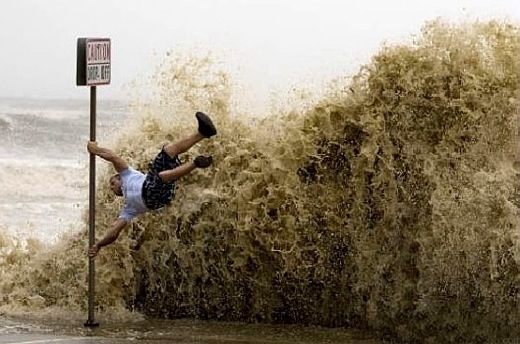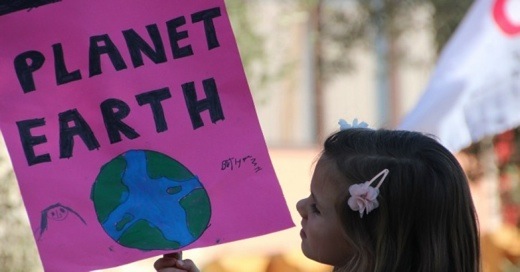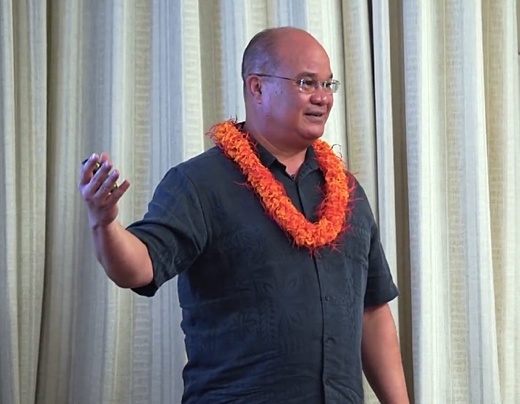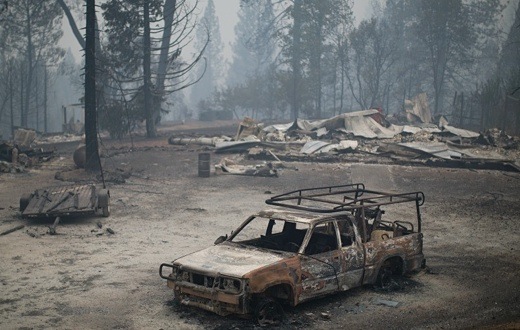SUBHEAD: The Bravo H-bomb test had an unexpected wind shift heavily contaminating many populated atolls.
By Dahr Jamail on 24 October 2018 for TruthOut -
(
https://truthout.org/articles/the-us-tested-bombs-on-the-marshall-islands-now-victims-are-seeking-justice/)
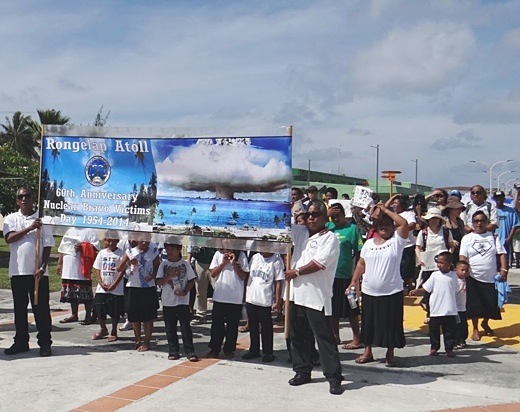 Image above: Islanders from nuclear weapons test-damaged Rongelap Atoll march on 1 March 2014 while holding banners marking the 60th anniversary of the Bravo hydrogen bomb test at Bikini Atoll in Majuro. Photo by Isaac Marty.From original article.
Image above: Islanders from nuclear weapons test-damaged Rongelap Atoll march on 1 March 2014 while holding banners marking the 60th anniversary of the Bravo hydrogen bomb test at Bikini Atoll in Majuro. Photo by Isaac Marty.From original article.
A dozen years before Jiji Jally was born in the Marshall Islands, the US conducted the Bravo test, the single largest above-ground nuclear detonation in the world.
The US’s nuclear bomb testing in the Marshall Islands amounted to the equivalent of detonating 1.6 Hiroshima bombs every single day for 12 years. The Bravo test on Bikini Atoll alone was the nuclear equivalent of more than 1,000 Hiroshima-sized bombs.
Jally’s family, like hundreds of others, has lived with the scars of this ever since.
“Everybody I know in the Marshall Islands has stories of cancer in their families,” Jally, who lives in Tumwater, Washington where she works as a court and medical interpreter, told Truthout.
Her brother died in 2012, leaving behind his wife and two young boys. Given that he died in the Marshall Islands, which lacks any facilities to diagnose and treat cancer, the cause of his death is unknown. But Jally explained that he had a tumor, and believes it was from cancer.
“Then my cousin passed a few years ago, who was in her mid-thirties,” she added. “And she died of breast cancer, and left three boys and a girl behind.”
For Jally, working as a medical interpreter highlighted the health care disparity her Marshall Islands community faces, even here in the US. She has therefore become an advocate for their right to health care.
“People from the Marshall Islands are moving out of there looking for healthcare,” Jally said. “But some of them come to Washington and are told they don’t qualify for health insurance or health care.
A Marshallese man in our community is undergoing chemo from his cancer that he got from the bombings, and now he has to stop his chemo because he can’t afford to continue the treatment. It’s really sad to me what we are having to go through just to get health care now, given what happened.”
The injustice of this is not lost on her or on others in her immediate community. However, most Americans have little understanding of what the US government has inflicted on the Marshallese people.
“The Cold War was not ‘cold’ for the Marshallese…it was hot,”
Holly Barker, who is a professor at the University of Washington and a commissioner on the Republic of Marshall Islands National Nuclear Commission (a three-person commission with the goal of advancing nuclear justice for the Marshallese people), told Truthout.
“‘Cold’ communicates the privilege of being far from the testing locations and not having to live with firsthand experiences with nuclear weapons.”
President Donald Trump recently announced plans to remove the US from the Intermediate-Range Nuclear Forces (INF) Treaty with Russia, a move which many fear could ignite a new nuclear arms race. The INF had banned all short and mid-rang nuclear and non-nuclear missiles, and helped to eliminate thousands of land-based missiles. Trump has also promised to build new nuclear weapons.
As a deadly reminder of the lingering health impacts from nuclear weapons testing during the Cold War, untold numbers of Marshall Islands residents continue to seek healthcare, and justice, for having unwittingly been made human test subjects to nuclear tests.
According to Barker,
multiple types of cancer continue to beset the Marshallese. Adequate healthcare might be a first step toward justice – but so far, that step is far from realized.
Marshall Islands' Cancer Rate "Extreme"
In 1947 the US made an agreement with the UN to create a strategic trusteeship territory across islands of Micronesia, an area covering three million square miles comprised of two thousand islands.
Just five days after obtaining the agreement with the UN, the US Atomic Energy Commission established what it called the Pacific Proving Grounds and shortly thereafter began testing nuclear weapons in the atmosphere and underwater across the region.
One-hundred-and-six tests over a dozen years were conducted, many of them extremely high yield. While the Marshall Islands testing were only 14% of all US nuclear tests, they comprised nearly 80% of the total nuclear yields detonated by the US.
Many Marshall Islands residents were exposed to radiation and nuclear fallout, and many of the islands remain contaminated to this day. Through the Radiation Exposure Compensation Act of 1990, money was paid to the Marshal Islanders as compensation for their exposure to the testing, but generations later the problem persists.
There are no exact numbers regarding how many people across the Marshall Islands were impacted, directly or indirectly, by the nuclear tests. Although the US government — like the governments of so many colonial powers — has minimized the consequences of its testing, its effects continue to this day.
“Does ‘affected’ mean those exposed to radioactive fallout, those whose land was vaporized and no longer exists on this planet?” Barker asked. “Is it people whose land will be contaminated for thousands of years into the future, is it the people whose chromosomes/DNA are mutated by the mutagenic properties of radiation?”
Barker, who has been studying the plight of the Marshallese for decades, admits that coming up with exact numbers is difficult and the numbers remain unknown.
“It is difficult because it plays into US efforts to minimize the numbers of people and islands whose health and land were damaged and injured by the testing program,” she said. “It is not just health and environmental damage, however. The political system was altered, the culture, the economy, and the language, among other things.”
In the late 1990s, a study published in Cancer, the journal of the American Cancer Society, found that cancer rates in the Marshall Islands, caused by the combination of exposure to nuclear test fallout, malnutrition, and other factors associated with the rapid westernization of their society, were “alarming,”
according to the study.
Neal Palafox with the University of Hawaii’s John A. Burns Medical School, who authored the study along with four colleagues,
told the media at the time the study was released that the incidence of cancer in the Marshall Islands was “extreme.”
The study compared the rate of various cancers found in the Marshallese to rates in the US. “Cancer incidence rates were higher in virtually every category in the Marshall Islands compared with the United States for the period 1985-1994,” the
study said.
As just one example, the study found liver cancer rates in the Islands to be 15 times higher in males and 40 times higher in females compared to rates for those cancers in the US.
The study referenced the 67 nuclear tests conducted across the islands, and
added that “increases in leukemia, breast cancer and thyroid cancer after radiation exposure have been well established, especially in childhood exposures.”
Erasing History
Rachael Hoffman, a Marshallese woman living in Everett, Washington, works with Barker in educating the public and younger generations about what the US government did in the Marshall Islands.
Every year she helps organize a Remembrance Day ceremony marking the March 1, 1954, detonation of the Bravo Bomb.
Her grandmother developed thyroid cancer that she attributes to the nuclear tests, and received some compensation from the government for it. With that money, she was able to move to the US, along with some of her relatives, during the 1980s.
“67 nuclear bombs were tested in the Marshall Islands in a 12-year span,” Hoffman told Truthout. “People were relocated from island to island, and to this day people remain displaced from nuclear testing.”
Hoffman discussed how the rapid westernization of the culture led to a poor diet taking a toll on the health of the Marshallese.
“During the testing a lot of the food was imported because people were overcrowded on these islands they were relocated to,” she explained. “The crops and fish were poisoned, so people couldn’t eat off the land, so they had to rely on canned food which caused high blood pressure, high cholesterol and diabetes.”
There were four main coral atolls of the Marshall Islands that were primarily impacted, and the people living on those have the highest numbers of cancer cases.
“These are the people who own the nuclear story because they are the ones facing the radiation directed illnesses and diseases and death that has come from all of this,” Hoffman said.
Today she works towards engaging younger people in the Marshallese community, both in the US and on the islands, “so they can know their story, know their history, otherwise that story will be lost.”
Hoffman said that is one of the main reasons she works annually to organize the Remembrance Day, so that these stories are not lost.
“The young people have no idea how bad the nuclear testing was that was done to our people,” Hoffman said, “because it’s definitely not taught in schools.”
Lack of Care
In the Marshall Islands, there is practically no medical diagnostic ability, no forensics, and not even an oncologist, according to Jally, Hoffman and Barker. This makes it challenging to find accurate numbers of cancer incidence.
“We know that many people died on the outer islands, for instance, with symptoms that sound like cancer,” Barker said. “Thyroid cancer, cervical cancer, breast cancer, lung cancer, colon cancer are all issues.”
Thomas Hamilton is an endocrinologist and thyroid disease specialist who did
groundbreaking research on the impacts of the nuclear testing on the Marshall Islands community.
In a
1991 report he produced for Physicians for Social Responsibility, Hamilton
stated, “The testing of nuclear weapons on these islands…has had profound direct and indirect effects on the health of the Marshall Islands residents as well as on their environment and culture.”
Hamilton
concluded that the initial exposure of the Marshallese from the 1954 Bravo test “could probably have been prevented entirely or significantly reduced” by evacuating the residents prior to the test, as had been done prior to other tests; evacuating them immediately after the test; or at least postponing the detonation for when it was known the winds would not bring the fallout atop the Marshallese people.
The report points out that additional exposure could have been prevented by postponing the return of people who had been evacuated to the islands, or evacuating them again “when it was known that their body burdens of radionuclides were steadily increasing.”
Needless to say, the just, humanitarian and ethical thing for the US government to do would have been not to conduct nuclear testing in the region in the first place, let alone in an area where people lived.
The report was also critical of the US Department of Energy’s studies of the health impacts of the nuclear tests on the Marshallese,
saying the DOE’s studies had “significant limitations.”
Hamilton told Truthout that his work studying the health impacts on the Marshallese from the nuclear tests “was not welcomed by the US government,” and pointed to the fact that as recently as
2013 a government study on the topic went to great lengths to invalidate the results
of some his work.
While it has now been decades since Hamilton was deeply engaged in his studies of the testing’s health impacts on the Marshallese, he told Truthout that the findings of one of his studies,
published in 1987, showed that the nuclear fallout went “quite a bit further” than the DOE had acknowledged.
“The Bravo test had an unexpected wind shift that caused heavy contamination in many atolls, but certainly on Rongelap Island, so those folks were allowed to stay where the fallout, which was like snow on the ground and kids were playing in it,” Hamilton said. “And it was two to three days before those people were evacuated.”
Hamilton added, “I was surprised in 2013 that they [US Government] mentioned my study, so they are somehow still concerned there’s an article out there saying their studies weren’t as complete as they should be.”
Meanwhile, Barker argues that, since the Marshall Islands was a US territory when the testing occurred, the Marshallese deserve the same standard of cancer care as Americans (at least those who can afford decent health insurance).
“But as it is, people have to leave the country and all that is familiar and comfortable to them at the time when they need the most support and comfort,” Barker said.
Meanwhile, like so many other Marshallese, Jally struggles to live with what was done to her people.
“I grew up there not knowing the history of our country,” she said. “I graduated high school and became a parent and didn’t really know the history until I started working with the community as a medical interpreter.”
Jally explained that her elders have spoken very emotionally of the bombings, telling her, “Yes, that happened to us and we lived through it.”
“The old folks watch these films about what happened and they tear up, and a lot of their families have died from cancer or because they are diabetic,” she concluded. “There is a lot of trauma in our community from this.”
.